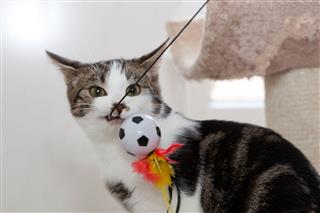
The most popular, yet simplest of all cat breeds, is the domestic shorthair cat. The fact that it is not a recognized breed has not stopped people from keeping it as a pet.
You can keep a dog, but it is the cat who keeps people, because cats find humans useful domestic animals.
― George Mikes
There are many domestic cat breeds, which come in various shapes, sizes, and colors. Interestingly, the most popular among them is not the lofty Manx or the snobby Siamese. It’s the humble domestic shorthair or domestic short-haired cat. Calling it the ‘mutt’ of the cat world seems a generalization. The terms ‘stray cat’ or ‘alley cat’ seem equally insulting.
Domestic Shorthair Cat Facts
- The domestic shorthair (DSH) is not a recognized breed or pure breed cat.
- DSHs are of mixed ancestry, which is very difficult to trace. If they resemble a pure breed, it is purely by chance―not genetically.
- Do not confuse a domestic shorthair with an American shorthair or British shorthair, both of which are recognized Cat Fanciers’ Association (CFA) breeds.
- The key difference between a purebred American shorthair and a domestic shorthair is the consistency in physical features. A pedigreed cat will produce a litter of kittens with the same features, coat quality, and temperament. But with a DSH, even kittens of the same litter will look and act different.
- Domestic shorthair cats account for 95 percent of the domestic cat population in North America.
- It is thought that the African wildcat, Felis silvestris lybica is the true ancestor of the domestic shorthair. Except for the sandy and black striped coloring of the wildcat, there are very few physical differences between them.
Physical Characteristics of Domestic Shorthair Cats
Adult males have an average weight of 11 – 15 lb. Adult females weigh between 8 – 12 lb.
- They reach maturity at 3 – 4 years of age. Their average lifespan is 15 – 20 years.
- The key characteristic of a domestic shorthair is its dense, sleek, short coat. Hence, it requires minimal grooming. Brushing the coat to remove loose or dead hair, should be done once in a while.
- While there is no fixed body type or size, DSH cats exhibit slight regional differences. A stocky build with a thick coat is prevalent among shorthair cats in cold regions of Europe and America. In contrast, those from warmer, more tropical climates, have a slim build, with a thinner, sleek coat.
- The head is wide between the ears, tapering down for an angular shape, with a pointed nose and fleshy cheeks. Ears are placed on top of the head. Tail is of medium length, level with the back and tapering at the tip. Eyes are large and round, with color complementing the body.
- Domestic shorthair cats have a wide range of coat patterns. Black and white (tuxedo) is a common color. Also common are tabby (striped with different patterns), tortoiseshell, and calico (tri-color) coats. Very rare colors are smokes, blues, and silvers, or unblemished, clear coats, free from stripes and spots.
Personality and Care of the Domestic Shorthair
The personality of a domestic shorthair is as unpredictable as a human. The normal aloof, independent attitude of a feline is present, but these cats are more friendly and social, as compared to pure breeds. They exhibit distinctive behavior; some are silly and goofy, some highly intelligent and smart. They can be calm or hyper, playful, or lazy. They are not very vocal, but are known universally for their loving and caring nature.
They make ideal family pets and pets for first-time cat owners. Their low maintenance and friendly temperament make them ideal first pets for children.
The interaction with other adults and children differs from cat to cat. Hence, it’s best to observe the cat’s behavior at the time of choosing. An alert and curious cat is the best choice. See if the cat approaches you freely and doesn’t hiss or shy away. If the cat runs away or struggles on being touched, don’t choose it. Do not choose passive and dull cats either.
Domestic shorthairs are generally disease and disorder free. But since their genetic history remains unknown, there could be a chance of some health issues. A noted issue with domestic shorthair cats is overeating, encouraged by the owner, and hence, they become obese and develop health problems.
Neuter or spay your domestic cat, as it is better for its lifespan and health. Do not overfeed it. A cat is a loving, affectionate companion, who senses your mood. The deep purring, rubbing against you, and even a long blink of their eyes are all cat ways of saying “I love you”. In the end, no matter which breed you choose, respect and treat cats with kindness.























